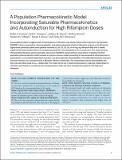A population pharmacokinetic model incorporating saturable pharmacokinetics and autoinduction for high rifampicin doses
Abstract
Accumulating evidence suggest that increasing doses of rifampicin may shorten tuberculosis treatment. The PanACEA HIGHRIF1 trial assessed safety, pharmacokinetics and anti-mycobacterial activity of rifampicin at doses up to 40 mg/kg. Eighty-three pulmonary tuberculosis patients received 10, 20, 25, 30, 35 or 40 mg/kg rifampicin daily over 2 weeks, supplemented with standard doses of isoniazid, pyrazinamide and ethambutol in the second week. This study aimed at characterizing rifampicin pharmacokinetics observed in HIGHRIF1 using non-linear mixed effects modeling. The final population pharmacokinetic model included an enzyme turn-over model accounting for time-dependent elimination due to auto-induction, concentration-dependent clearance and dose-dependent bioavailability. The relationship between clearance and concentration was characterized by a Michaelis-Menten relationship. The relationship between bioavailability and dose was described using an Emax relationship. The model will be key in determining exposure-response relationships for rifampicin and should be considered when designing future trials and when treating future patients with high dose rifampicin.
Citation
Svensson , R J , Aarnoutse , R E , Diacon , A H , Dawson , R , Gillespie , S H , Boeree , M J & Simonsson , U S H 2018 , ' A population pharmacokinetic model incorporating saturable pharmacokinetics and autoinduction for high rifampicin doses ' , Clinical Pharmacology & Therapeutics , vol. 103 , pp. 674-683 . https://doi.org/10.1002/cpt.778
Publication
Clinical Pharmacology & Therapeutics
Status
Peer reviewed
ISSN
1532-6535Type
Journal article
Description
The research leading to these results has received funding from the Swedish Research Council in addition to the Innovative Medicines Initiative Joint Undertaking (www.imi.europe.eu) under grant agreement n°115337, resources of which are composed of financial contribution from the European Union’s Seventh Framework Programme (FP7/2007-2013) and EFPIA companies’ in kind contribution.Collections
Items in the St Andrews Research Repository are protected by copyright, with all rights reserved, unless otherwise indicated.

